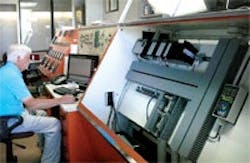Massachusetts Town Selects Alarm Network to Safeguard Wastewater System
Situated in the hills of western Massachusetts, Amherst is a city of about 37,000 people. Population growth in the area has been steady over the years, just about doubling since 1960. With the continuous expansion of the three college campuses—University of Massachusetts at Amherst, Hampshire College and Amherst College—the infrastructure has grown as well. Jim Laford, division supervisor of Amherst’s wastewater division, has witnessed that growth firsthand. His team is responsible for the integrity and reliability of the entire wastewater system. Backups and power outages at individual lift stations occur periodically, and a reliable, responsive alarm system is critical to ensuring that those problems are remedied.
Technology Advances
Laford has witnessed decades of technological evolution throughout his years with Amherst’s public works department. It started with offline local alarms in the 1970s, phone lines with dial-up alarms in the 1980s and most recently, a radio telemetry alarm system that transmitted from lift stations to the main treatment plant.
Radio telemetry might be effective in the plains of Nebraska or Kansas, but in the rugged landscape of Massachusetts’ Pioneer Valley, line-of-sight radio signals were problematic. Alarm signals had mixed success getting past the hills dotting the countryside. Repeaters eventually were added to boost system reach but high-rise dormitory construction created even greater barriers to radio signals. The wastewater district decided to scrap the system and replace it with something that addressed the unique topographical challenges.
A New Solution & A Fresh Start
RACO proposed AlarmAgent.com to address many of the dilemmas confronting Amherst, including the ability to reliably transmit alarm signals from lift stations to the treatment plant. Many of these unmanned stations were situated in remote locations where landlines were cost-prohibitive, so a wireless autodialer made a lot of sense. The company was awarded the contract and soon went to work implementing the system.
Upon completion, a wireless alarm network linked 20 lift stations with the main treatment plant. Because Amherst’s wastewater infrastructure was operated and monitored by a state-of-the-art SCADA system, an additional autodialer alarm package was installed to monitor the dedicated phone line for the SCADA system’s software-based alarm notification system. If the SCADA system went down, the entire wastewater system would be jeopardized. Without the additional alarm package, an outage might not be discovered for hours.
More Responsive & Proactive
AlarmAgent.com has protected the Amherst Wastewater Div. for a number of years. False alarms have been eliminated and response time for actual alarms has improved dramatically.
One of the most significant features of the new system contributes directly to diagnostics and preventive maintenance. Wastewater division personnel can access detailed reports on pump performance across all 20 lift stations by logging onto the alarm network’s online interface. These reports include information on pump flow, hours of pump operation and pump alternation. The data enable wastewater division personnel to address potential problems before they become alarm events.
Customer satisfaction in Amherst is up and man-hours at the wastewater division are down. The city and its college campuses continue to grow, putting increased demands on system capacity, but Laford and his colleagues are confident that they are ready to meet future challenges.
Download: Here
